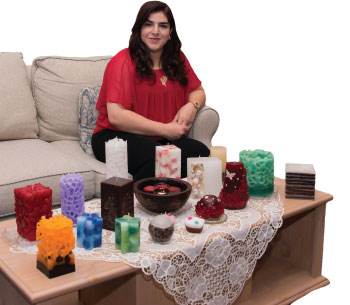After giving up her event planning business to spend more time with her children, Seema Haqiqi got creative. Georgie Bradley finds out how she went from scrapbooking to candle making for My Crafty Touch.
While the rest of her family are tucked in bed, Seema Haqiqi will be in her kitchen melting wax and carving candles through the night. “The kitchen is off limits for my children when I make candles: that’s why I wait till they are asleep,” she says.
For the sake of getting in more hours with her children, Seema put her dream business – an event planning company, to bed. “When my youngest started school, I then had a chance to go down a more artistic route which I believe was a gift from God for all the time I gave to my children.”
Before candle making took over her kitchen counter, Seema began scrapbooking as a morning time-filler, calling it My Crafty Touch. “I took photographs and put them on special background paper and decorated them with embellishments until I realised it was not challenging enough for me. Although the use of tools and techniques helped me use more sophisticated ones needed for candle making.”
 Seema learnt how to make candles with the help of DVD tutorials, YouTube and books with more books. “There is so much information on the different types of wax, moulds, wicks, dyes and fragrances, it was overwhelming, but my passion and enthusiasm helped.”
Seema learnt how to make candles with the help of DVD tutorials, YouTube and books with more books. “There is so much information on the different types of wax, moulds, wicks, dyes and fragrances, it was overwhelming, but my passion and enthusiasm helped.”
The chemistry of candle making was something Seema didn’t readily take to at first but understood its requisite part of the process. “You have to know the properties of wax because there are hazards in this line of work.”
The workspace – her kitchen countertop – is part technical, part therapeutic. The scientific tools: a blow torch, scales, knives for carving, a thermometer and mould spray are lined in order of use while the candles in working progress are tucked underneath tin foil. But that doesn’t stop the wafting scents from zapping your nostrils. She uses various fragrances based on the design of the candle, like roses – a favourite among the locals – jasmine, pinewood, coffee and cinnamon.
The only part her children play in the process is adding the finishing touches: “My youngest girl likes to help me with chunk candles by adding in chunks of coloured wax into the moulds that are wicked and ready. She says “Mummy, sell this candle last because I want it at home!”
Creating a candle from conception to the finished product can take a few days with up to seven hours of non-stop work, which is not always appreciated. “It’s very hard to sell my candles for the right price because the fact that they are handcrafted is not always valued.”
The average candle costs BD20-25 in an attempt to keep profit margins low. “I want to be able to market these candles as a work of art,” she says.
My Crafty Touch has appeared in fairs and has a growing following of customers on Instagram who can soon expect a candle book from Seema.
“I’m planning to write a candle-making book in Arabic because it’s difficult to find any. I have lots of customers on Instagram who ask me about the methods and techniques to make candles, so I will include all the basic things you need to know to start a candle-making hobby or business. I’m also planning to give training courses to those interested.”
Ultimately for Seema, candle making creates positive energy, “I used to be a high-tempered person but since I became a candle artist I started cooling down. It has restored peace in me.”
Visit My Crafty Touch on Instagram: @mycraftytouch or call +973 33712100.


































